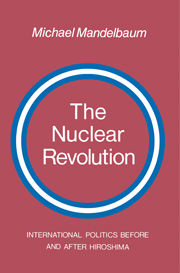Book contents
- Frontmatter
- Contents
- Preface
- 1 The nuclear revolution
- 2 Nuclear weapons and chemical and biological weapons
- 3 The balance of power in the nuclear age
- 4 Arms competition: The nuclear arms race and the Anglo–German naval rivalry
- 5 Arms competition: The nuclear arms race and tariff competitions
- 6 NATO: The nuclear alliance
- 7 The nuclear presidency
- 8 The bomb, dread, and eternity
- Notes
- Index
5 - Arms competition: The nuclear arms race and tariff competitions
Published online by Cambridge University Press: 26 January 2010
- Frontmatter
- Contents
- Preface
- 1 The nuclear revolution
- 2 Nuclear weapons and chemical and biological weapons
- 3 The balance of power in the nuclear age
- 4 Arms competition: The nuclear arms race and the Anglo–German naval rivalry
- 5 Arms competition: The nuclear arms race and tariff competitions
- 6 NATO: The nuclear alliance
- 7 The nuclear presidency
- 8 The bomb, dread, and eternity
- Notes
- Index
Summary
Optimizing doctrines
The United States and the Soviet Union have each accumulated weaponry with an eye on the other's nuclear arsenal for the same reasons that have underlain previous arms races: They have had different and opposed political goals and have regarded nuclear weapons as useful for reaching, and for preventing the other from reaching, those goals.
The pattern of rivalry between the two nuclear giants has had features common to other industrial arms races, notably the Anglo–German competition in capital ships before World War I. So far, the Soviet–American political rivalry has stopped short of war, unlike the rivalry between Britain and Germany before 1914, in part because of the nuclear character of the Soviet–American arms race. Its nuclear character has also helped to make the competition between the United States and the Soviet Union, unlike previous ones, self-perpetuating.
The Soviet–American arms race has another property, stemming from the unprecedented destructive capacity of nuclear weapons, that runs counter to its self-perpetuating character and sets it apart even more dramatically from all other arms races in all of recorded history. That property is a logical stopping point. The American government has reckoned that it needs to be certain of being able to inflict a certain amount of damage in response to Soviet aggression in order to prevent such aggression. The capacity to inflict that much damage is the standard that the United States has adopted for effective deterrence. It has been given the name “assured destruction.” Assured destruction has two singular features that make it a logical point for both the United States and the Soviet Union to stop acquiring nuclear weapons.
- Type
- Chapter
- Information
- The Nuclear RevolutionInternational politics Before and after Hiroshima, pp. 117 - 146Publisher: Cambridge University PressPrint publication year: 1981

